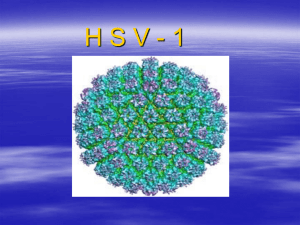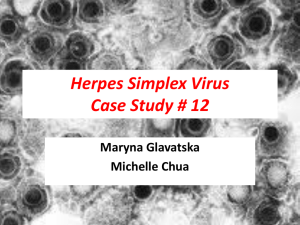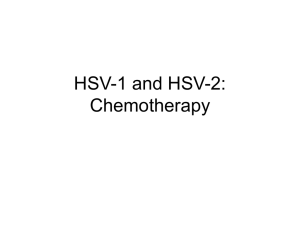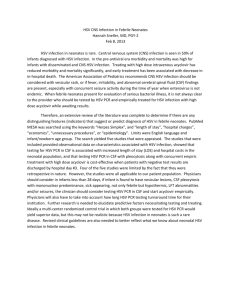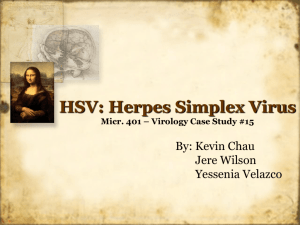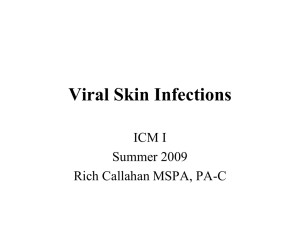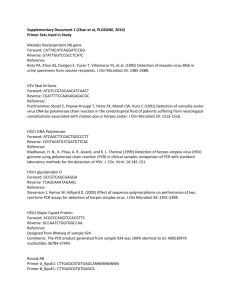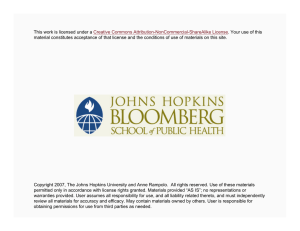CS12 Case Study MICR 401 - Cal State LA
advertisement
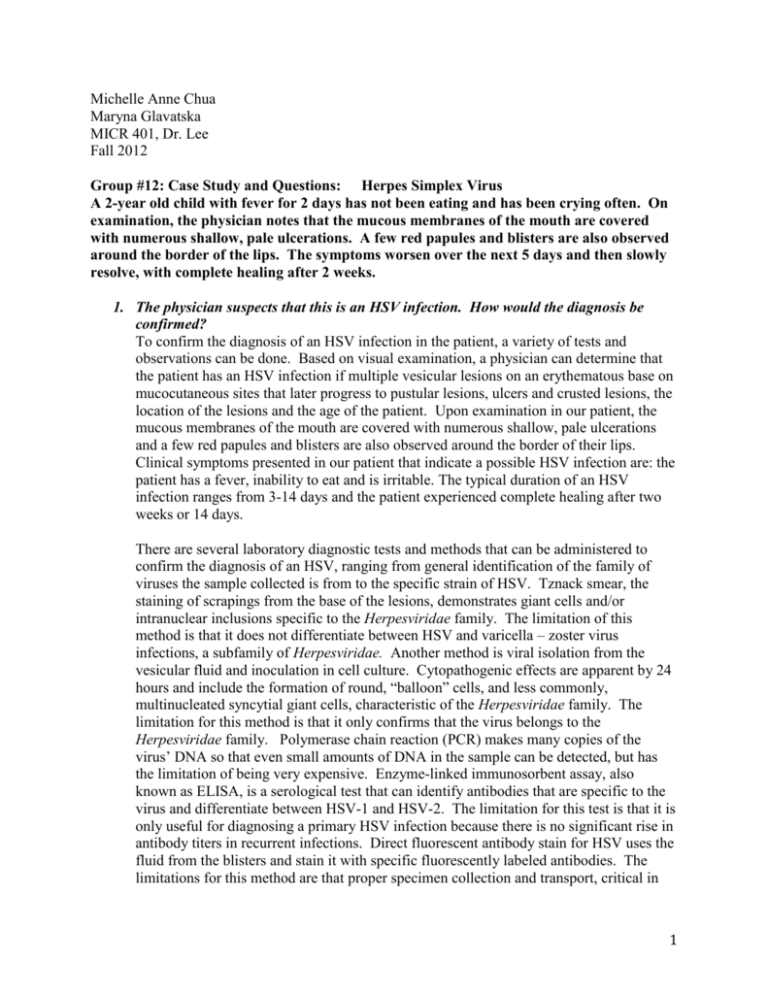
Michelle Anne Chua Maryna Glavatska MICR 401, Dr. Lee Fall 2012 Group #12: Case Study and Questions: Herpes Simplex Virus A 2-year old child with fever for 2 days has not been eating and has been crying often. On examination, the physician notes that the mucous membranes of the mouth are covered with numerous shallow, pale ulcerations. A few red papules and blisters are also observed around the border of the lips. The symptoms worsen over the next 5 days and then slowly resolve, with complete healing after 2 weeks. 1. The physician suspects that this is an HSV infection. How would the diagnosis be confirmed? To confirm the diagnosis of an HSV infection in the patient, a variety of tests and observations can be done. Based on visual examination, a physician can determine that the patient has an HSV infection if multiple vesicular lesions on an erythematous base on mucocutaneous sites that later progress to pustular lesions, ulcers and crusted lesions, the location of the lesions and the age of the patient. Upon examination in our patient, the mucous membranes of the mouth are covered with numerous shallow, pale ulcerations and a few red papules and blisters are also observed around the border of their lips. Clinical symptoms presented in our patient that indicate a possible HSV infection are: the patient has a fever, inability to eat and is irritable. The typical duration of an HSV infection ranges from 3-14 days and the patient experienced complete healing after two weeks or 14 days. There are several laboratory diagnostic tests and methods that can be administered to confirm the diagnosis of an HSV, ranging from general identification of the family of viruses the sample collected is from to the specific strain of HSV. Tznack smear, the staining of scrapings from the base of the lesions, demonstrates giant cells and/or intranuclear inclusions specific to the Herpesviridae family. The limitation of this method is that it does not differentiate between HSV and varicella – zoster virus infections, a subfamily of Herpesviridae. Another method is viral isolation from the vesicular fluid and inoculation in cell culture. Cytopathogenic effects are apparent by 24 hours and include the formation of round, “balloon” cells, and less commonly, multinucleated syncytial giant cells, characteristic of the Herpesviridae family. The limitation for this method is that it only confirms that the virus belongs to the Herpesviridae family. Polymerase chain reaction (PCR) makes many copies of the virus’ DNA so that even small amounts of DNA in the sample can be detected, but has the limitation of being very expensive. Enzyme-linked immunosorbent assay, also known as ELISA, is a serological test that can identify antibodies that are specific to the virus and differentiate between HSV-1 and HSV-2. The limitation for this test is that it is only useful for diagnosing a primary HSV infection because there is no significant rise in antibody titers in recurrent infections. Direct fluorescent antibody stain for HSV uses the fluid from the blisters and stain it with specific fluorescently labeled antibodies. The limitations for this method are that proper specimen collection and transport, critical in 1 the detection of etiological agents. A negative result does not rule out viral infection and has to be confirmed using PCR. The last diagnostic test that can be used to confirm an HSV infection is Western Blot blood test which can distinguish between type 1 and type 2 herpes simplex antibody with extremely high accuracy of about 99%. 2. How could you determine whether this infection was caused by HSV-1 or HSV-2? Considering the age of the patient, the location of the ulcerations, papules and blisters, and the clinical syndromes presented, the infection is caused by HSV-1. HSV-1 infections are usually associated with infections above the waist. To differentiate between HSV-1 and HSV-2, HSV type-specific probes, specific DNA primers for PCR and antibodies, are used. The distinction between HSV-1 and HSV-2 and different strains of either virus can also be made by restriction endonuclease cleavage patterns of the viral DNA. The cytopathic effect (CPE) caused by HSV-1 and HSV-2 present differences and can be seen in cell culture. HSV-1 produces CPE throughout the cells’ monolayer and HSV-2 CPE tend to be focal. Although HSV-1 and HSV-2 have many antigens in common, the glycoprotein G (gG) antigen is unique to each type; gG1 is only found on HSV-1 and gG2 is only found on HSV-2. ELISA based tests can be used to to detect type-specific IgG antibodies with a sensitivity of around 90%. Western blot and PCR can also be used to differentiate whether the infection was caused by HSV-1 or HSV-2. 3. What immune responses were most helpful in resolving this infection, and when were they activated? In a primary infection, interferon and natural killer cells serve important roles in limiting the progression of the infection. Interferon activates the natural killer cells, which recognize HSV-infected targets and lyse the cells. Macrophages phagocytize viral antigens and present them to CD4 helper T cells and B cells to activate antigen-specific immunity. Mononuclear cells travel to the site of infection and infiltrate the infected tissue. Delayed hypersensitivity and cytotoxic T killer responses assist the natural killer cell and activated macrophages in killing the infected cells. In addition to assisting in the resolution of the infection, immunopathologic changes caused by the cellular immune and inflammatory responses can exacerbate the symptoms. Both the innate (immediate) and adaptive (late, after 96 hours) arms of the immune response are involved. The humoral arm of the response, usually antibodies against surface glycoproteins, leads to neutralization. However, the virus can escape the immune system by coating itself with IgG via the Fc receptors and complement receptors. The virus can also spread from one cell to another without entering the extracellular space and coming in contact with humoral antibodies. This means that the cell-mediated responses are vital in controlling herpes infections. The adaptive immune response is important in disease progression, latency and control of virus spread. CD8+T cells recognize viral peptides by MHC class I molecules on the infected cell surface and kill the cell and play an important role in the production of IFN (interferon) γ. IFN γ controls the spread of the virus, keeping it localized. 2 4. HSV escapes complete immune resolution by causing latent and recurrent infections. What was the site of latency in this child and what might promote future recurrences? The site of latency in the patient is the trigeminal ganglion. HSV-1 infections usually establish latency in the trigeminal ganglion, a collection of nerve cells near the ear. Recurrent infections tend to be seen on the lower lip or face. HSV-2 infections tend to reside in the sacral ganglia at the base of the spine where it recurs in the genital area. Recurrent infections are usually caused by the reactivation of the virus despite the presence of an antibody. The trigger is usually stress, which may have a dual effect: 1) promote the replication of the virus in the nerve and 2) to depress cell-mediated immunity transiently. Other triggers that might promote future recurrences include sunlight, fever, wind, cold, physical injury, upset stomach, surgery, menstruation, suppression of the immune system and emotional stress. Oral herpes can also be provoked within 3 days of intense dental work, particularly root canal or tooth extraction. 5. What were the most probably means by which the child was infected with HSV? The probably means by which the child was infected with HSV can be due to a number of scenarios. Since the child is fairly young, HSV-1 is typically contracted by receiving a social kiss from a relative or by sharing of utensils. Another scenario could be being in direct contact with a playmate that has a prior HSV infection. As long as the child is in direct contact with others, there is a possibility of contracting HSV. Since children have no prior infection to any HSV type, they have no immune defense against the virus. 6. Which antiviral drugs are available for treatment of HSV infection? What are the targets? Were they indicated for this child? Why or why not? Acyclovir (ACV) is the most effective anti-HSV drug. It targets viral DNA polymerase after it has been phosphorylated by viral thymidine kinase to acyclovir monophosphate. Host cell enzymes further the phosphorylation to acyclovir triphosphate and the compound then binds viral DNA polymerase and may also be incorporated into viral DNA, terminating synthesis. Acyclovir would be recommended for the child to use because it is very safe to use and it is highly effective in treating HSV infections. Other antivirals on the market are ganciclovir, famciclovir and valacyclovir, which have a similar mechanism of action as acyclovir of inhibiting viral DNA replication, however ganciclovir is more toxic. Valacyclovir is an analog of acyclovir and is quickly converted to acyclovir in the tissues. Famciclovir is converted to the active antiviral penciclovir Topical antivirals used to treat HSV infections are penciclovir cream and acyclovir cream but neither are highly effective. The target the replicating virus so they are ineffective against the latent virus. None are recommended for the child since ganciclovir has a high toxicity, famciclovir and valacyclovir have to be converted to an active form before therapeutic effects are noticeable and are usually used to treat HSV-2 infections. 3 References: 1. Murray, P., Rosental, K., Pfaller, M. Medical microbiology. Fifth edition. 2005. 2. Braunwald, F., Wilson, I., Kasper, M., Longo, H. Harrison’s Principles of Internal Medicine. Fourteenth editions. Volume 1. 1998. 3. Murphy, K. Janeway’s Immunobiology. Eigth Edition. 2012. 4. Slonczewki, J., Foster, J. Microbiology An Evolving Science. Second Edition. 2009. 5. Wagner, E., Hewlett, M., Bloom, D., Camerini, D. Basic Virology. Third Edition. 2008. 6. Hitner, H., Nagle, B. Pharmacology. Sixth Edition. 2012. 7. http://pathmicro.med.sc.edu/virol/herpes.htm 8. http://www.herpes.com/hsv1-2.html 9. http://health.nytimes.com/health/guides/disease/herpes-simplex/diagnosis.html 10. http://www.zeusscientific.com/fileadmin/media/pdfs/inserts/elisa/infectious/R2206E.PD F 4
